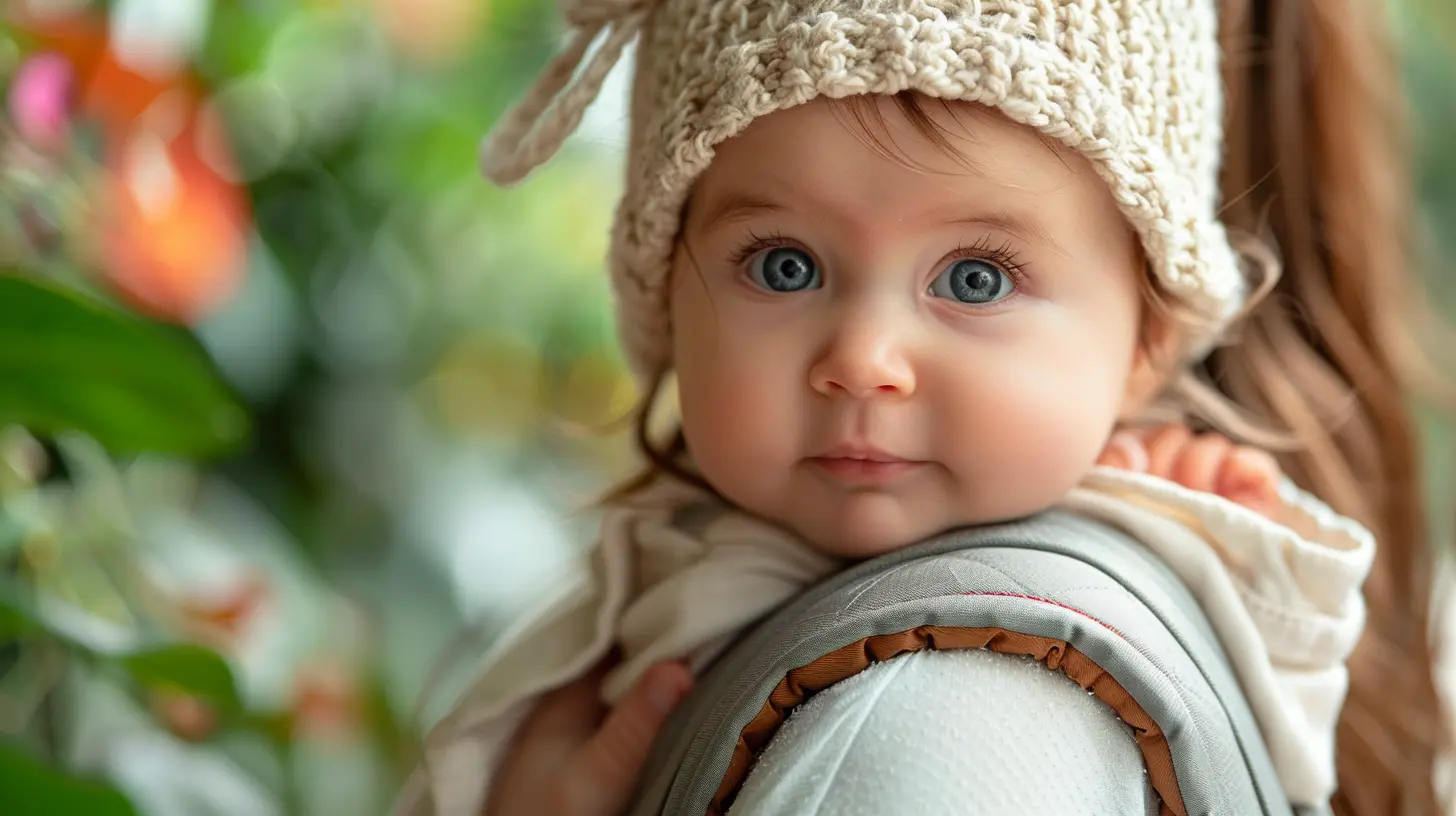25 November 2024
Bringing your newborn baby home is a whirlwind of joy, sleepless nights, and above all - learning to juggle life in a completely new way. It can be overwhelming, right? I mean, suddenly, you don’t just have your two hands to worry about. You need at least six hands to get through the day! Baby wearing can be a total lifesaver (seriously), but it’s not as simple as just popping your baby into a carrier and getting on with your day. There’s an art to it – and more importantly, there’s a safe way to do it.
Let's dive deep into what you need to know about baby wearing and how you can do it safely to keep your little one snug, secure, and content while still having some freedom to move around like a human!

What Is Baby Wearing?
First things first. If you’re a new parent, all the different terms can make your head spin. So, what exactly is baby wearing? Simply put, it's just like it sounds – carrying your baby using a carrier that keeps them close to your body.It has been practiced for centuries across many cultures, and for good reason. Aside from keeping your hands free, baby wearing can help foster that strong bond between you and your newborn – after all, they spent nine months cozy inside you. It's no wonder they love staying close!
Plus, after birth, babies crave the warmth and familiarity of being held close. Baby wearing simulates that womb-like environment, keeping them calm, while giving you a bit more flexibility. Sounds like a win-win, right?
But like with any other newborn-related task, safety is priority number one. Let’s explore some safe baby wearing practices so you and your baby can truly enjoy this bonding experience.

The Benefits of Baby Wearing
Why should you consider baby wearing? Well, aside from the obvious hands-free convenience, it comes loaded with some pretty awesome benefits:1. Physical Closeness
Newborns thrive on skin-to-skin contact. Baby wearing allows you to keep your baby close, which can help regulate their body temperature, heart rate, and even breathing. They’ll feel safe and secure – just like they did in the womb.2. Soothes Fussy Babies
Is your little one going through a cranky phase? Baby wearing can work like magic. The gentle rocking motion as you walk around while wearing your baby may calm them faster than anything else. Think of your baby carrier like an emotional blanket – it’s comforting, calming, and protective.3. Helps with Bonding
When you're carrying your baby close to your chest for extended periods, you're fostering a bond that goes beyond the regular cuddles. You become attuned to their breathing, little movements, and sounds. It’s like an all-access pass to understanding your baby’s world.4. Mental and Emotional Development
Babies who are worn tend to experience the world through their parent’s eyes. Studies show that they cry less and spend more time in a state of "quiet alertness," where they can absorb their surroundings. Think of it as providing your baby with a front-row seat to life.Alright, now that we've established why baby wearing is awesome, let's chat about the most important part: how to do it safely.

Safe Baby Wearing Practices: What You Need to Know
Carrying your newborn the wrong way can lead to discomfort or, worse, pose risks to their health. So, how do we strike the perfect balance between comfort and safety?Let’s break it down into five essential safety tips:
1. T.I.C.K.S. – The Ultimate Safety Checklist
You’re going to hear this a lot in the baby wearing community, so it's important to remember. TICKS is an acronym that outlines the basic safety principles of baby wearing. Let’s break it down:- Tight: Your baby should be snug against your body. Loose fabric can cause them to slump down, which can compromise their airway.
- In View At All Times: You should be able to see your baby’s face without having to move fabric or tilt their head.
- Close Enough to Kiss: You want your baby high enough on your chest that you can tilt your head down and kiss their forehead easily.
- Keep Chin Off the Chest: Your baby’s chin should never be resting on their chest because that can restrict their airflow.
- Supported Back: Ensure your baby's back is supported, and they are held in a natural, ergonomic position—curved with their bottom lower than their knees.
This simple checklist ensures that your baby is positioned safely and securely every single time.
2. Choose the Right Carrier
Not all carriers are created equally, and you’ve probably noticed that there are several types: ring slings, wraps, soft-structured carriers, and more. So how do you choose one? It’s all about the fit!- Newborn Wraps and Slings: These are often a favorite because they mimic the snugness of the womb. They allow skin-to-skin contact and are ideal for newborns. Soft wraps made of stretchy fabric are great for this purpose.
- Structured Carriers: These are better suited for babies over three months or when your little one can hold their head up on their own. They offer more support and can be worn for longer durations.
Regardless of the style you choose, always make sure it conforms to safety standards and offers adequate support for your baby’s neck and back.
3. Mind the Airway
The number one rule of baby wearing is making sure that your little one's airway remains clear. A newborn’s airway can become restricted if their chin drops to their chest, making it difficult for them to breathe. That’s why you’ll hear many experts emphasize keeping your baby in an upright position.An easy way to check is to ensure there’s a finger-width of space between your baby's chin and chest. This small space can make a big difference in keeping their airway open.
4. Dress Baby Appropriately
Think of your baby carrier as an extra layer of clothing. Babies can’t regulate their body temperatures very well, so it's important to be mindful that they don’t get too hot or too cold.If you’re baby wearing in warm weather, consider dressing your little one in lightweight fabrics like cotton. In colder months, you’ll want to ensure they stay cozy, but you shouldn’t over-bundle them. Layers are your best friend! Always check your baby’s temperature by feeling their neck or chest—if they’re sweaty or too cool, adjust accordingly.
5. Support Their Hips and Legs
One of the most common mistakes in baby wearing is not offering enough support to a newborn’s hips. Babies should always be positioned with their legs in an “M” shape – which means their knees are higher than their bum, and their legs are spread to the sides of your body.This position mimics a natural squatting stance and protects against hip dysplasia, a condition that can occur when the baby’s hips develop abnormally. Always ensure that your carrier allows for this healthy hip positioning!

Baby Wearing Mistakes to Avoid
Even seasoned parents can sometimes overlook the basics. Be on alert for these common mishaps:1. Wearing Baby Too Low
If your baby is down by your waist, that’s a no-go. Always keep your baby positioned high on your chest, close enough to kiss the top of their head.2. Overloading the Carrier
Listen, I get it—life with a baby means you have stuff, and you probably want to carry everything but the kitchen sink when you leave the house. But resist the temptation to overload yourself. Keep your baby and essentials, and avoid unnecessary strain.3. Ignoring Baby’s Cues
As much as we love baby wearing, it’s important to remember that every baby is different. Some babies love being worn for hours, while others might prefer it in short stints. Always tune in to your baby’s cues and make adjustments as needed.When Not to Wear Your Baby
There are times when baby wearing isn’t safe. For example, you shouldn't engage in activities that require active body movements while wearing your baby (like running or cycling). Also, avoid baby wearing in situations where you’re not sure you'll be able to maintain proper posture or where there’s a risk of falling.Additionally, if your baby falls asleep while being worn, be extra vigilant about their positioning. Make sure their chin doesn’t drop to their chest, and their body remains well-supported.
Conclusion: A Bonding Experience Like No Other
Baby wearing is a wonderful way to bond with your little one, offering so many benefits for both parent and child. But, as with everything in parenting, safety is key. By remembering the TICKS checklist, choosing the right carrier, and paying attention to your baby’s positioning, you can ensure a safe and enjoyable baby wearing experience.Ultimately, baby wearing is all about finding a rhythm that works for both you and your newborn. It may take some practice, but once you’ve got the hang of it, you’ll wonder how you ever lived without it. Here’s to happy, safe, and snuggly baby wearing!









Lena Pope
Baby wearing can be a beautiful way to bond with your newborn while keeping them close and secure. Prioritizing safety through proper techniques and choosing the right carrier fosters both comfort and confidence, enhancing the connection between you and your little one.
February 2, 2025 at 4:50 PM